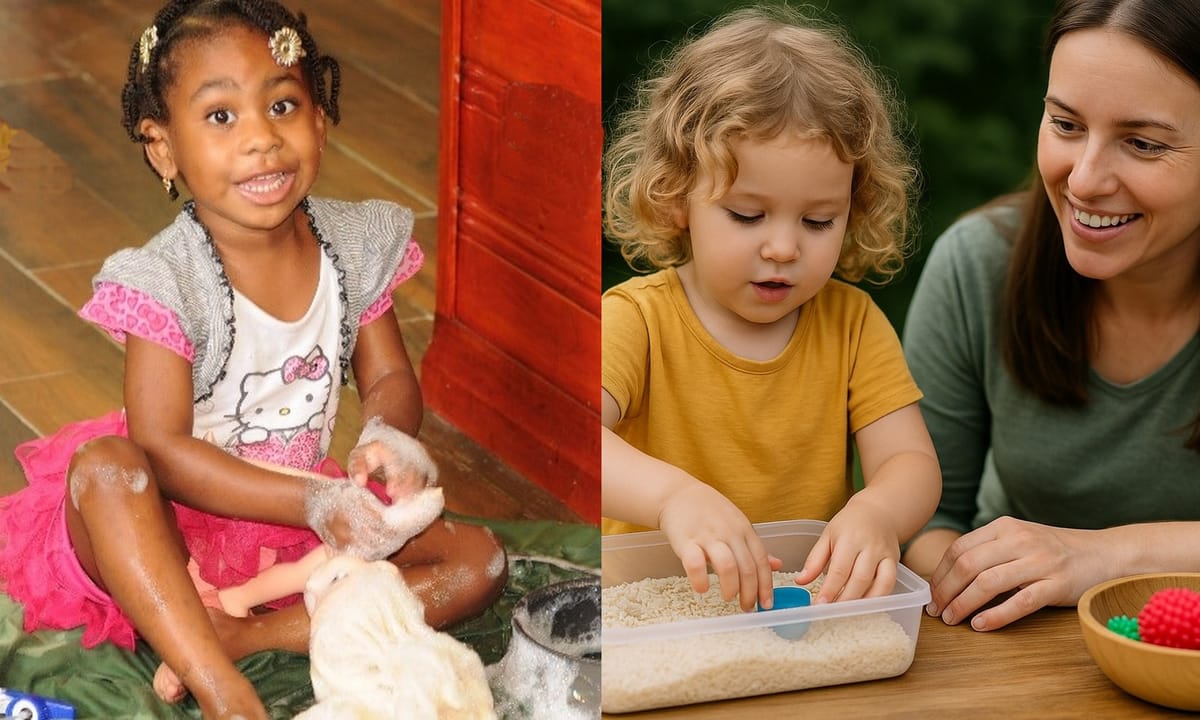Squish, Splash, Grow: Learning Through the Senses

What if your child’s sticky fingers and muddy toes were signs of powerful brain growth?
Have you ever watched your child lose themselves in a simple, joyful activity—like running their hands through a bowl of dried cereal, smearing finger paint across a page, or giggling while squishing playdough? Something remarkable is happening: your child is growing. Yet many parents overlook the importance of intentionally supporting sensory growth.
In our GREATEST framework for purposeful parenting, highlighted in the Introductory post. G stands for Growth—not just physical, but also emotional, cognitive, language, and social. Sensory play is a powerful way to nurture whole-child development while deepening your connection as a parent.
Sensory Growth in Real Life
Take this scene: a toddler presses their fingers into a bowl of ice cream, gleefully announcing, “It’s soft!” and “cold!”—they’re starting to recognize and name textures. A preschooler tips over a cup of water in the bath and shouts, “It splashed!”—a moment of understanding cause and effect. Or imagine a kindergartener, overwhelmed after school, quietly scooping and pouring dry pasta at the kitchen table to self-soothe and reset.
One afternoon, my granddaughter Amara spent an hour in the backyard concocting “mud stew.” I hesitated at the mess, but I let her be. That one muddy hour supported her imagination, fine motor skills, emotional regulation, and her joy.
Why Growth Through Sensory Play Matters
Growth is not just about milestones—it includes learning, feeling, and connecting.
Sensory play engages your child’s senses: touch, sight, sound, smell, and taste. For an infant, it might be grasping a soft cloth. A toddler may enjoy the mess of a squishy banana or the splash of water. A preschooler might dig into a bin of rice to find hidden treasures. These seemingly simple experiences boost brain development, encourage focus, and build emotional awareness.
A 2013 study linked sensory-rich environments to neural growth in language and motor areas.[1]
A 2018 study suggests that play-based sensory interventions, such as yoga, may improve self-regulation and attention in preschool-aged children.[2]
When parents join in—without judgment—they model curiosity, build trust, and create a safe emotional space for connection.
Making Sensory Play Inclusive
Every child is unique. Sensory play should meet them where they are. Consider these adaptations:
- For children with sensory sensitivities: Start with dry textures, or let them observe first. Noise-canceling headphones may ease auditory overload.
- For physical limitations: Use larger items or adaptive tools like scoops and grips. Seated or supported play works too.
- For developmental differences: Simplify instructions, offer visual cues, and slow down the pace.
The key is flexibility: allowing each child to explore at their own pace and in their way.
Encouraging Growth Through Sensory Play
Here are some simple ways to enrich sensory experiences:
- Add sensory variety: Try warm or cool water, herbs, or essential oils. Ask, “Does that feel bumpy or smooth?”
- Take it outside: Grass, dirt, leaves—nature is full of free tools for exploration.
- Accept the mess: Keep wipes handy, but don’t let cleanup stifle curiosity.
- Use what’s around you: Everyday items like baking bread or crunching dried leaves can offer rich sensory input.
- Enjoy the beach: Sand, water, and sun provide ideal sensory stimulation.
Reflection Prompt
What’s one moment this week when you noticed your child learning through sensory play?
Conclusion
Through sensory play, children thrive—and so do parents. Each splash, squish, or sniff is a small step toward learning, connecting, and growing together. Forget perfection. Embrace presence.
Footnote
<sup>1</sup> Gascón, M., et al. (2013). The Role of Sensory Experiences in Brain Development. Journal of Child Psychology.
<sup>2</sup> Cohen, S. C., et al. (2018). Effects of Yoga on Attention, Impulsivity, and Hyperactivity in Preschool-Aged Children with ADHD Symptoms. American Journal of Occupational Therapy, 78(Supplement_2), 7811500270p1.